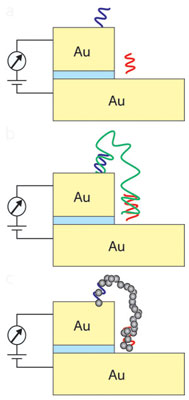| Posted: March 31, 2010 |
An ultrasensitive electronic DNA sensor array speeds up disease diagnostics |
|
(Nanowerk News) A novel electronic sensor array for the rapid, accurate and cost-efficient testing of DNA for disease diagnosis has been designed by A*STAR researchers ("Mass-Produced Nanogap Sensor Arrays for Ultrasensitive Detection of DNA").
|
|
“Our nanogap sensor array can unambiguously detect the concentration of DNA quantitatively and may obviate the need for target amplification used in current DNA tests,” says team leader Zhiqiang Gao of the A*STAR Institute of Bioengineering and Nanotechnology, Singapore.
|
|
Current clinical methods for DNA detection use a technique called the polymerase chain reaction (PCR) to amplify the target DNA sequence enough for it to be detected—an expensive and time-intensive process. A number of different research teams have recently examined the use of ultrasensitive ‘nanogap sensor arrays’ to avoid the use of PCR, but are yet to resolve problems such as low detection limits, unreliable results and background noise.
|
|
Gao and his team tweaked a published sensor design to overcome these issues. “[Our] novel vertical nanostructure design allows ultrasensitive detection of DNA,” says Gao. “This sensitivity is best-in-class among electrical DNA biosensors,” he adds.
|
 |
| Fig. 1: Schematic of the DNA sensor array. Each array within the device consists of two electrodes, each with a different capture probe (red and blue), separated by an insulating layer (top). Target DNA (green) gets captured by these probes, bridging the insulating gap (center). DNA is coated in silver to create a conductive path for carrying electrical current between the electrodes (bottom). (Reproduced from Ref. 1 © 2010 American Chemical Society)
|
|
When designing the single-use device, Gao’s team also incorporated standard silicon microfabrication technologies to improve the feasibility of scaling their fabrication for cheap, mass production.
|
|
Each array within the sensor consists of a pair of gold microelectrodes separated by a 5–20 nanometer insulating layer, known as a nanogap, fabricated onto silicon wafers using standard photolithography techniques (Fig. 1). In each array, the two microelectrodes have different ‘capture probes’—pieces of DNA immobilized on their surface that recognize and capture the target disease DNA strand. If the disease DNA sequence is present it will be captured between these two probes, forming a bridge over the insulating gap between the electrodes. The second stage involves coating these DNA ‘bridges’ with silver so that they can conduct an electric signal. This means that in the presence of the disease DNA sequence, the array will conduct electricity, and in its absence it will not.
|
|
According to Gao, multiple different arrays can be included within each sensor, meaning that several hundred diseases, such as cancers, Parkinson’s disease and Huntington’s disease, can be screened for simultaneously. “We expect that this device can be used for all diseases that have nucleic acid biomarkers,” he adds.
|
|
The team is currently testing this device against disease DNA indicative of disease, but Gao notes that further optimization and scale-up will be needed before it can be used for point-of-care analysis.
|

